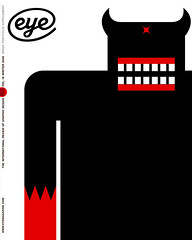Winter 2006
Stereotyping for pictures, power and profit
Typecasting: On The Arts and Sciences of Human Inequality
By Elizabeth and Stuart Ewen. Seven Stories Press, USD 34.95<br><br>
Stereotyping was the name given by the French printer Fermin Didot in 1794 to his novel printing process by which papier maché moulds were made from pages of handset type and used to produce duplicate plates, cast in metal. That stereotyping – the all-too-common act of classifying human beings – began as a graphic arts process is sobering. As Elizabeth and Stuart Ewen note in their important new book, Typecasting, ‘Within recent history, the media’s capacity to spawn mass impressions instantaneously, has been a pivotal factor in the dissemination of stereotypes.’ By more than mere implication graphic designers and illustrators have been in large part responsible for the untruths.
In this encyclopedic collection of brief but intense essays, the Ewens trace the origins and manifestations of ‘typecasting’ or stereotyping and the myths largely perpetrated for the purpose of maintaining power and establishing hierarchies of race, ethnicity, gender and class. They show how the exploitation of difference has been used as a political, social and religious weapon in the propagation of hierarchical systems.
The stereotype became a more significant social tool – a means to shape what Walter Lippmann called ‘public mind’ – during what the Ewens label the ‘Age of Spectatorship’ of the early twentieth century. But the reliance on stereotyping as a social determinant begins earlier during the Middle Ages when nascent capitalism emerges. A world engaged in exploration and mercantile trade obliterated many of the boundaries that separated peoples and cultures. Population shifts from rural to urban owing to ‘enclosure movements,’ whereby once open farm and grazing lands were now circumscribed by strict boundaries, forced migration to cities. The new inhabitants needed to be taught their respective places, and thus fit into proscribed types.
Add to this the rise of colonialism, when the quest to accumulate riches introduced waves of different cultural manifestations into cities such as London and Paris. As occupied territories, colonies had to be managed in large part by keeping their populations in subservient positions, their economies stunted to serve the needs of the colonists. ‘In each case,’ write the Ewens, ‘the ability to use words, images, scientific and religious theories to envelope the conquered or the dispossessed in a cloak of moral, intellectual, and physical inferiority helped to make violent contacts and inveterate inequality justifiable.’ Such words and images enabled the self-proclaimed civilisers’ practices to seem less barbaric than they were.
Typecasting builds an essential historical document with relevance to today’s world. The chapter ‘Visual Truth’ sheds light both on the stereotypes of the artist (‘often typecast as a passionate advocate of personal vision’), and what the artist often produces in the name of subjectivity. The Ewens note that the role of the artist was at one time totally entwined with the needs of the Church in the confines of the monastery. Eventually, though human eye took on a more independent importance. In this sense the Ewens ascribe great significance to the pin-hole camera, and ultimately to lenses (which were invented in the mid-sixteenth century) for the development of a ‘visual vernacular’ that was in sync with science. From this emerge both more accurate stereotypes – ‘The capacity to produce apparently exact replicas of the physical world’ – and more in-depth means of collecting and classifying physiognomic differences.
In Typecasting, the Ewens’ exploration brings together science, myth, religion and art in ways that few graphic design books have ever done. In chronicling taxonomies of numerous official types, the Ewens have provided an invaluable textbook on the way in which our visual perceptions and misperceptions have been perpetuated in ways both benign and evil. Why did white, for instance, become superior to other skin hues?
The answer lies in Johann Friedrich Blumenbach (1752-1840), a professor of medicine, who published Treatise on the Natural Variety of Mankind in 1795, in which he determined that pinnacle of human perfection is a woman who came from a region in Georgia, in the Caucasus. He named this bloodline Caucasian (even though the Russians have long seen Caucasians as gangsters). The line is the single most erroneous mythology today.
Their study shows that even in the realm of stereotyping everything is contextual. Certain fears of difference seem to have made sense at various times in history, even if the results – exploitation, persecution, extermination – are senseless by our standards today. Eugenics, the pseudo-science developed by the Englishman, Francis Galton,
cousin of Charles Darwin, had many adherents, including such liberals as George Bernard Shaw and H. G. Wells. Little could they predict that the Nazis would take Eugenics to its next radically criminal extreme – but the roots were there.
The Ewens have provided a valuable history, but Typecasting also sheds needed light on the processes of persuasion and misinformation today. In many advertising agencies, publicity firms and design companies, typecasting is carried out as a matter of course. It has become such a part of our communications business routine that it is easy to ignore. The Ewens show that too many of the world’s persistent ills derive from the populace’s happy ignorance.
Steven Heller, design writer, New York
First published in Eye no. 62 vol. 16 2006
Eye is the world’s most beautiful and collectable graphic design journal, published quarterly for professional designers, students and anyone interested in critical, informed writing about graphic design and visual culture. It is available from all good design bookshops and online at the Eye shop, where you can buy subscriptions and single issues.

